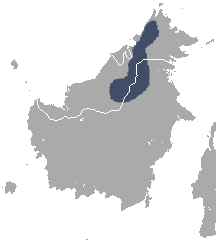
Nepenthes campanulata, the bell-shaped pitcher-plant, is a tropical pitcher plant native to Borneo. It has also been reported from Palawan, the Philippines, though further field work is needed to confirm this identification.

The golden-naped barbet is a member of the family Megalaimidae. It is found in Indonesia and Malaysia, where it is endemic to the island of Borneo. Its natural habitats are subtropical or tropical moist lowland forest and subtropical or tropical moist montane forest.

The Bornean smooth-tailed treeshrew is a species of treeshrew in the family Tupaiidae. It is endemic to Borneo. Its natural habitat is subtropical or tropical dry forests. It is threatened by habitat loss.

Prevost's squirrel or Asian tri-colored squirrel is a colourful species of rodent in the family Sciuridae. It is found in forests in the Thai-Malay Peninsula, Sumatra, Borneo and nearby smaller islands, with an introduced population in northern Sulawesi. Although the Prevost's squirrel is declining is some regions because of habitat loss and hunting, the species is not considered threatened since it generally remains common and widespread. It can live in somewhat disturbed habitats and often visits plantations or gardens. It mostly feeds on plant material, especially fruits, but also takes insects.
Anisophyllea globosa is a tree of Borneo in the family Anisophylleaceae. The specific epithet globosa is from the Latin meaning "round", referring to the fruits.
Anisophyllea nitida is a tree of Borneo in the family Anisophylleaceae. The specific epithet nitida is from the Latin meaning "polished", referring to the shiny appearance of the upper leaf surface.
Canarium fuscocalycinum is a tree of Borneo in the incense tree family Burseraceae. The specific epithet fuscocalycinum is from the Latin meaning "dark calyx".
Canarium sarawakanum is a tree of Borneo in the incense tree family Burseraceae. The specific epithet sarawakanum is from the Latin, referring to the species being native to Sarawak.
The micrantha is a wild citrus from the papeda group, native to southern Philippines, particularly islands of Cebu and Bohol. Two varieties are recognized: small-flowered papeda, locally known as biasong, and small-fruited papeda or samuyao.
Durio kinabaluensis, also known as mountain durian and (locally) as durian tapuloh, is a forest tree in the mallow family.
Lasjia erecta is a species of forest tree in the protea family that is endemic to the island of Sulawesi, Indonesia. Its closest relative is Lasjia hildebrandii, also a Sulawesi endemic.
Vatica albiramis is a tree in the family Dipterocarpaceae, native to Borneo. The specific epithet means "white twigs".
Toechima monticola, also known as mountain tamarind, is a species of plant in the lychee family that is endemic to Australia.
Durio crassipes, also known as durian hutan, is a species of flowering plant in the mallow family that is endemic to Borneo.
Bouea oppositifolia, also known as plum mango, kundang, kundangan or remenia, is a species of flowering plant, a fruit tree in the mango family, that is native to Indochina and Southeast Asia.
Mangifera griffithii is a species of flowering plant, a fruit tree in the mango family, that is native to Southeast Asia.
Willughbeia angustifolia is a species of flowering plant, a woody monoecious vine in the dogbane family, that is native to Southeast Asia.
Garcinia microcarpa, also known as kandis hutan, is a species of flowering plant, a dioecious understorey fruit tree in the mangosteen family, that is native to Southeast Asia.
Garcinia nitida, also known as kandis hutan, is a species of flowering plant, a dioecious understorey fruit tree in the mangosteen family, that is native to Southeast Asia.

Artocarpus lanceifolius, also known as keledang in Malay and more locally as timakon or kaliput, is a species of flowering plant, a fruit tree in the fig family, that is native to Southeast Asia.




